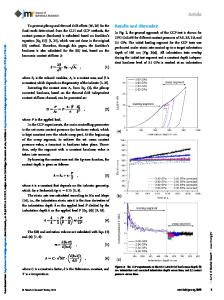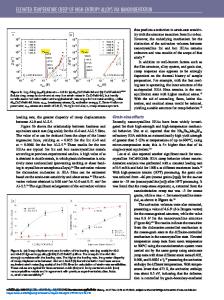Nanoindentation creep in polycarbonate and syndiotactic polystyrene
- PDF / 112,422 Bytes
- 6 Pages / 584.957 x 782.986 pts Page_size
- 8 Downloads / 392 Views
Mao-Kuo Wei Department of Materials Science and Engineering, National Dong Hwa University, Hualien 97401, Taiwan
Julie P. Harmon Department of Chemistry, University of South Florida, Tampa, Florida 33620-5250
Sanboh Leea) Department of Materials Science and Engineering, National Tsing Hua University, Hsinchu 30013, Taiwan (Received 7 June 2011; accepted 15 December 2011)
This study focuses on nanoindentation creep in polycarbonate (PC) and syndiotactic polystyrene (sPS) throughout the transient and steady-state regions. The viscoelastic Burgers model is used to explain transient creep data, while the power-law creep model is used to interpret steady-state creep data. The Newtonian shear viscosity of the Maxwell element and Young’s modulus of the Kelvin element are greater for the creep period than for the preload period, and an opposite trend is noted in the Newtonian shear viscosity of the Kelvin element and Young’s modulus of the Maxwell element. The fact that the Young’s moduli of Maxwell and Kelvin elements in the creep period are different from those in the preload period implies that a stress-induced mesomorphic structure forms or that crystallization occurs in nanoindentation creep. While the strain rate increases with decreasing preload period, the stress exponent factor is almost the same for all preload periods. I. INTRODUCTION
The depth-sensing indentation technique has drawn attention for several decades. Oliver and Pharr1 proposed a model to calculate Young’s modulus based on the assumption that the material exhibits pure elastic behavior. Data acquired for metals, ceramics, polymers, and composites exhibited a range of behaviors and this prompted researchers to undertake extensive studies to improve the methodology for this technique.2–11 When viscoelastic effects arise between indenter tip and specimen, the Young’s modulus obtained by the Oliver and Pharr method does not produce accurate results. To alleviate this problem, Briscoe et al.12 suggested imposing a long creep period at the peak load before unloading. Yang et al.13 proposed a semiempirical elastic–viscoelastic–viscous model to explain the creep behavior of polymers under rapid loading speeds using a Berkovich nanoindenter which employs a three-sided pyramid tip. Tweedie and Vliet14 found that linear viscoelastic behavior was not noted in polymers when the creep compliance was measured by a conical or other sharp nanoindenter, regardless of the loading rate. Goodall and Clyne15 proposed a power-law creep method to analyze steady-state nanoindentation creep. The above literature failed to explain the whole range of nanoindentation creep displacement curves. Liu et al.10 explained loading and unloading displacement curves by using the viscoelastic Burgers model in
which a Maxwell element is connected with a Kelvin element in series. Huang et al.11 used the viscoelastic Burgers model and power-law creep model to explain transient and steady-state nanoindentation creep of amorphous polymers. Our laboratory is currently interpreting a serie
Data Loading...











